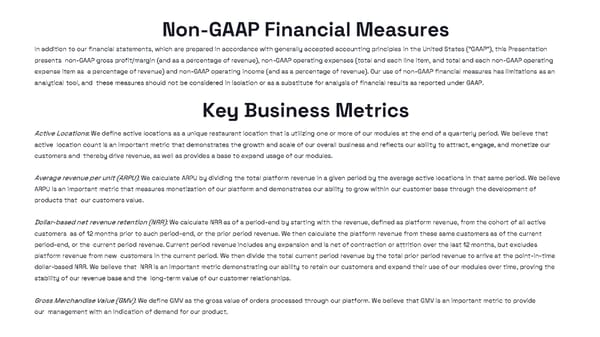Non-GAAP Financial Measures In addition to our financial statements, which are prepared in accordance with generally accepted accounting principles in the United States (“GAAP”), this Presentation presents non-GAAP gross profit/margin (and as a percentage of revenue), non-GAAP operating expenses (total and each line item, and total and each non-GAAP operating expense item as a percentage of revenue) and non-GAAP operating income (and as a percentage of revenue). Our use of non-GAAP financial measures has limitations as an analytical tool, and these measures should not be considered in isolation or as a substitute for analysis of financial results as reported under GAAP. Key Business Metrics Active Locations: We define active locations as a unique restaurant location that is utilizing one or more of our modules at the end of a quarterly period. We believe that active location count is an important metric that demonstrates the growth and scale of our overall business and reflects our ability to attract, engage, and monetize our customers and thereby drive revenue, as well as provides a base to expand usage of our modules. Average revenue per unit (ARPU): We calculate ARPU by dividing the total platform revenue in a given period by the average active locations in that same period. We believe ARPU is an important metric that measures monetization of our platform and demonstrates our ability to grow within our customer base through the development of products that our customers value. Dollar-based net revenue retention (NRR): We calculate NRR as of a period-end by starting with the revenue, defined as platform revenue, from the cohort of all active customers as of 12 months prior to such period-end, or the prior period revenue. We then calculate the platform revenue from these same customers as of the current period-end, or the current period revenue. Current period revenue includes any expansion and is net of contraction or attrition over the last 12 months, but excludes platform revenue from new customers in the current period. We then divide the total current period revenue by the total prior period revenue to arrive at the point-in-time dollar-based NRR. We believe that NRR is an important metric demonstrating our ability to retain our customers and expand their use of our modules over time, proving the stability of our revenue base and the long-term value of our customer relationships. Gross Merchandise Value (GMV): We define GMV as the gross value of orders processed through our platform. We believe that GMV is an important metric to provide our management with an indication of demand for our product.
 Olo Investor Presentation Microsite Page 15 Page 17
Olo Investor Presentation Microsite Page 15 Page 17